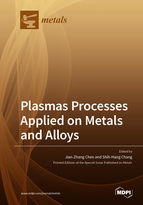Plasmas Processes Applied on Metals and Alloys
A special issue of Metals (ISSN 2075-4701).
Deadline for manuscript submissions: closed (31 August 2019) | Viewed by 36222
Special Issue Editors
Interests: plasma processing; atmospheric pressure plasma; dielectric barrier discharge; flexible electronics; solar cells; supercapacitors; metal oxides; wide-bandgap materials
Special Issues, Collections and Topics in MDPI journals
Interests: atmospheric pressure plasma materials processing technology; surface modifications; organic and polymer coatings; shape memory alloys; high damping materials
Special Issues, Collections and Topics in MDPI journals
Special Issue Information
Dear Colleagues,
Plasma technology is a versatile tool for materials processing. The ability to deposit and modify materials provides many practically useful functions to materials processing and thin film deposition. Plasma technology has been extensively used in thin film depositions, surface modification, substrate cleaning, materials cutting, and metallurgy, etc. To support the continuing development of this fast-growing research topic, we have organized a Special Issue of Metals to invite researchers worldwide to showcase their research results. Regular length papers, short communications and review articles on plasma technology applied to metals, alloys, and high conductivity materials such as carbonaceous materials are invited.
Topics of interest include, but are not limited to, the following:
- Plasma coatings
- Plasma surface modifications
- Plasma-enhanced chemical vapor deposition (PECVD)
- Sputtering
- Atmospheric pressure plasma
- Dielectric barrier discharge
- Microplasmas
- Plasma spray
- Plasma cutting
- Plasma metallurgy
Prof. Shih-Hang Chang
Guest Editors
Manuscript Submission Information
Manuscripts should be submitted online at www.mdpi.com by registering and logging in to this website. Once you are registered, click here to go to the submission form. Manuscripts can be submitted until the deadline. All submissions that pass pre-check are peer-reviewed. Accepted papers will be published continuously in the journal (as soon as accepted) and will be listed together on the special issue website. Research articles, review articles as well as short communications are invited. For planned papers, a title and short abstract (about 100 words) can be sent to the Editorial Office for announcement on this website.
Submitted manuscripts should not have been published previously, nor be under consideration for publication elsewhere (except conference proceedings papers). All manuscripts are thoroughly refereed through a single-blind peer-review process. A guide for authors and other relevant information for submission of manuscripts is available on the Instructions for Authors page. Metals is an international peer-reviewed open access monthly journal published by MDPI.
Please visit the Instructions for Authors page before submitting a manuscript. The Article Processing Charge (APC) for publication in this open access journal is 2600 CHF (Swiss Francs). Submitted papers should be well formatted and use good English. Authors may use MDPI's English editing service prior to publication or during author revisions.
Keywords
- Plasma
- Sputtering
- Plasma-enhanced chemical vapor deposition (PECVD)
- Atmospheric pressure plasma
- Dielectric barrier discharge
- Microplasma
- Plasma spray
- Coatings
- Surface modification
- Plasma cutting
- Plasma metallurgy







